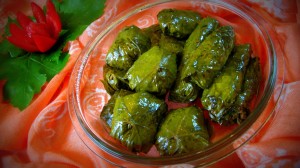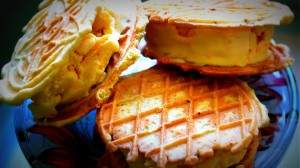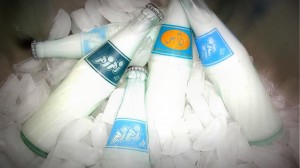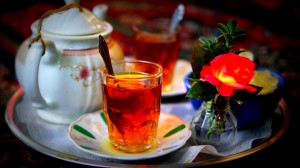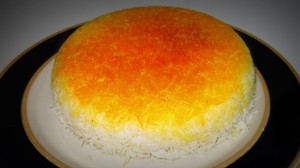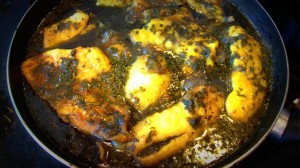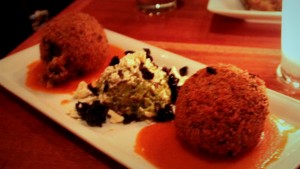History of Iranian Food & Cuisine
Iranian food or Persian cuisine refers to the traditional and modern styles of cooking originating in Iran. Situated between the Mediterranean Sea, Central Asia, the Caucasus, the Indian subcontinent, and Anatolia, Iranian cuisine has a shared history and ingredients with Mesopotamian cuisine and Mediterranean cuisine. Fresh green herbs are frequently used along with fruits such as plums, pomegranates, quince, prunes, apricots, and raisins.
Typical Persian main dishes are combination of rice with meat, lamb, chicken, or fish and some onion, vegetables, nuts, and herbs. To achieve a balanced taste, characteristic Persian flavorings such as saffron, dried limes, cinnamon, and parsley are mixed delicately and used in some special dishes.
Iranian national cuisine: Rice

Iranian rice with Zafran
It is believed that rice (berenj in Persian) was brought to Iran from the Indian subcontinent in ancient times. Varieties of rice in Iran include champa, rasmi, anbarbu, mowlai, sadri, khanjari, shekari, doodi, and others. Basmati rice from Pakistan is very similar to these Persian varieties and is also readily available in Iran. Traditionally, rice was most prevalent as a major staple item in the rice growing region of northern Iran, and the homes of the wealthy, while in the rest of the country bread was the dominant staple. The varieties of rice most valued in Persian cuisine are prized for their aroma, and grow in the north of Iran.
Rice cooking methods
There are three primary methods of cooking rice in Iran:
Polo
rice is prepared by soaking in salted water then boiling it. The parboiled rice (called chelo) is drained and returned to the pot to be steamed. This method results in an exceptionally fluffy rice with the rice grains separated and not sticky. A golden rice crust is created at the bottom of the pot called Tah-deeg (literally “bottom of the pot”). Tah-deeg is served plain, with thin breads such as lavash or slices of potato. Meat, vegetables, nuts and fruits are sometimes added in layers or completely mixed with the chelo and then steamed, such as BaghaliPolo, Lubia Polo, Zereshk Polo and Sabzi Polo.
When chelo is in the pot the heat is reduced and a piece of thick cloth or towel is place on top of the pot to absorb excess steam.Chelo is plain rice served as an accompaniment to a stew or kebab (chelo khoresh badenjan, chelo kabab), while Polo is rice mixed with something (such as Baghali Polo, Zereshk polo, Loubia Polo). They are otherwise cooked in the same way.
Kateh
rice that is cooked until the water is absorbed completely. This is also the traditional dish of Gilan Province.
Damy
cooked almost the same as Kateh but at the start ingredients that can be cooked thoroughly with the rice are added such as grains and beans such as lentil in “Adass Polo”. In making Kateh the heat is reduced to minimum when the rice and other ingredients are almost cooked. If kept long enough on the stove without burning and over-cooking Damy and Kateh can also produce Tah-deeg. Damy literally means “steaming”.
A special form of Damy is Tah-chin, that is a mixture of yogurt, lamb (or chicken) and rice plus saffron and egg yolks. However, chicken Tah-chin is more common than lamb Tah-chin.
Fruits and vegetables

Salad Shirazi
Iran’s agriculture produces many fruits and vegetables, including what some other countries may consider “exotic”. A bowl of fresh fruit is common on most Persian tables and dishes of vegetables and herbs are standard sides to most meals. Iran is one of the top date producers in the world; some special date cultivars, such as Rotab, are grown in Iran.
For generations, Iranians have been eating fruits, vegetables, and herbs for health benefits that have recently been discovered in other parts of the world. For example, onions and garlic, pomegranate, and sabzijat (various green herbs) are regular ingredients in many Persian dishes.
While the eggplant (aubergine) is “the potato of Iran”, Iranians are fond of fresh green salads dressed with olive oil, lemon juice, salt and pepper, and a little garlic. Vegetables such as pumpkin, spinach, green beans, broad beans, courgettes, varieties of squashes and carrots are commonly used in rice and meat dishes.
Tomatoes, cucumbers and scallions often accompany a meal. A small sweet variety of cucumber is popularly served as a fruit.
Dolma describes any vegetable or fruit stuffed with rice or a rice-and meat mixture. The term dolma describes any vegetable or fruit stuffed with rice or a rice-and meat mixture: grape vine leaves, cabbage leaves, spinach, eggplant, sweet peppers, tomatoes, even apples and quince.
The most popular dolmas in Iran today are stuffed grape leaves, which are prepared by lightly parboiling the fresh leaves in salted water, then stuffing them with a mixture of ground meat, rice, chopped fresh herbs such as parsley, split peas, and seasoning.
The above are only a few examples of the combination of meats and vegetables, or meats and fruits plus seasonings that may go into chelo khoresh, a favorite Iranian dish that is served at least once daily. This is a dish of crusty baked rice topped by one of the stews listed, or any one of dozens more, limited only by price and availability of ingredients.
Drinks and desserts
Iranian traditional icecream: frozen clotted cream sandwiched between two thin crispy waffles.
Traditional Iranian ice cream often contains flakes of frozen clotted cream and is most commonly naturally flavoured with saffron and rose water.
It is usually served sandwiched between two thin crispy waffles The traditional drink accompanying Iranian dishes is doogh, a combination of yogurt, still or carbonated water, salt, and dried mint. Other drinks include sherbets known as Sharbat and Khak shir. One favorite is Aab-e Havij, alternately called havij bastani, carrot juice made into an ice cream float and garnished with cinnamon, nutmeg or other spices.
Doogh!
These are commonly made in stands or kiosks in streets on summer days and on hiking trails. Aab Anaar (pomegranate juice) is also popular and has recently (2007) become popular in North America. Sekanjebin is a thick syrup made from vinegar, mint and sugar, served mixed with carbonated or plain water. It can be drunk mixed with a little rosewater or used as a dip for Romaine lettuce.
Other popular sweets include Zulbia, Bamieh and Gush-e Fil. Bamieh is an oval-shaped piece of sweet dough, deep-fried, and then covered with a syrup traditionally made with honey. Bamieh is similar to tulumba, but much smaller, 2 or 3 centimeters wide at most. Zulbia is made of the same sort of batter, also deep-fried, but poured into the oil in swirls, then covered with the same syrup (or with honey). Goosh-e Fil (lit. elephant’s ear) is also made of deep-fried dough, in the shape of a flat elephant’s ear, and then covered with powdered sugar.
Popular sweets Zulbia, Bamieh.
One of the classics, Halvardeh (Tehrani for halvā-arde, from halvā, an Arabic loan word meaning ‘sweet’, plus arde, the Persian word for tāhini). Halvā comes in various qualities and varieties, from mainly sugar to sesame seed paste (the aforementioned Persian arde), and pistachios. Noghl, sugar-coated almonds, are often served at Iranian weddings.
Essential accompaniments
There are certain accompaniments (mokhalafat) which are essential to every Iranian lunch (nahar) and dinner (shaam), regardless of the region. These include a plate of fresh herbs, called sabzi khordan (basil, cilantro, fenugreek, green onion, mint, radish (black, red, white), savory (marzeh, origany or sweet fennel), tarragon, Persian watercress or (shaahi), a variety of flat breads, called naan or noon (sangak, lavash, barbari), fresh white cheese (panir, somewhat similar to feta), walnut, sliced and peeled cucumbers, sliced tomatoes and onions, yogurt, and lemon juice. Persian gherkins (khiyarshur) and mixed pickles (Torshi) are also considered essential in most regions.
Iranian tea (chai)
Tea (chai) is served at breakfast. It may be served at other times, based on the region, usually many times throughout the day. For example, in the province of Khorasan it is served immediately before and after lunch and dinner. The traditional methods of tea preparation and drinking differ between regions and peoples.
Iranian regional cuisine
Northern Iran
Kateh is the traditional dish of North of Iran (provinces of Gilan, Mazandaran and Golestan) and is simply Persian rice cooked in water, butter and salt until the water is fully absorbed.
This method results in rice that is clumped together and is the predominant style of cooking rice in the Caspian region. In Gilan, Golestan and Mazandaran, kateh is also eaten as a breakfast meal, either heated with milk and jam, or cold with Persian cheese (panir) and garlic.
Kateh is simply Persian rice cooked in water.
Kateh is commonly eaten in other parts of Iran because of its short cooking time and easy preparation, and is prescribed widely as a natural remedy for those who are sick with the common cold or flu, and also for those suffering from stomach pains and ulcers. Some of the foods like Chegdermeh are only used in Turkmen region of Golestan Province , but many other dishes are used in all parts of Iran.
Iranian caviar and Caspian fish roes hails from that region, and is served with eggs, in frittatas (Kuku sabzi) or omelettes. North of Iran is home to the most numerous list of recipes compared to other regions. The most favorite dishes of this region are:
|
Khuzestan
Seafood is the most important part of Khuzestani cuisine, but many other dishes are also featured. The most popular Khuzestani dish is Ghalieh Mahi, a popular fish dish that is prepared with heavy spices, onions and cilantro. One of the fish used for grilled fish is locally known as mahi soboor (shad fish), a species of fish found in the Arvand river ( Arvand rood )
Ghalieh Mahi, a popular fish dish that is prepared with heavy spices.
Other provincial specialties include Ghalieh Meygu (“shrimp stew”), ashe-mohshala (a Khorramshahri breakfast stew), sær shir (a Dezfuli breakfast of heavy cream), hælim (a Shushtari breakfast of wheatmeal with shredded lamb), and kohbbeh (a deep-fried rice cake with ground beef filling and other spices of Arabic origin, a variant on Levantine kibbeh). Also see Iranian cuisine.
Esfahan
Esfahan in Central Iran is home to dishes and delicacies such as: Fesenjān, Sohān-e-Asali, Khoresht-e-mast, Yogurt Stew an dmost notable: Berian/Beryun-Biryani. This dish is made of mutton or lamb which is ground/minced and then cooked on one side in a special small pan over open fire. Berian is generally eaten with a certain type of bread, known as “nān-e-taftun”.
Azerbaijan
Kufteh Tabrizi is a Tabrizi traditional food
Kufteh Tabrizi is a Tabrizi traditional food
- Ghormeh sabzi (Herb Stew) and Gheimeh (Split-pea Stew) are traditional stews of Azerbaijan.
- Ghabli
- This traditional dish in Azerbaijan is made of rice, lentil, meat, potato and groats.
- Garniyarikh
“the torn abdomen” in Azeri
- Kufteh Tabrizi
A kind of Kofteh that unusually large.
- Tabriz is notable for its delicious cookies in Iran, some of which are
- Ghorabiye
- Eris
- Nogha ( نُوقا in Persian and Azeri) :That’s a special kind of Gaz made mainly in the Azeri regions of Iran. Nogha is almost exclusively made with walnuts instead of pistachios and almonds which are usual for other types of Gaz. The making of Nogha is very much the same as any other Gaz. The difference is that Nogha is usually spread between two very thin layers of wafers and cut into 10x5x5cm sections which are larger than ordinary Gaz cubes.
Persian cuisine abroad
Persian cuisine is sometimes confused with Middle Eastern cuisine, a much broader and more general term. Many Persian super-markets and restaurants are labelled as Middle Eastern, International, or Mediterranean in order to broaden their appeal to the Western consumer. Persian cuisine has similarity to Turkish and Greek cuisines in its Kebabs and other dishes due to cultural contacts with Greeks and Turks.
Although not widely recognized, Persian cuisine is gaining popularity in multicultural cities, especially in London, Los Angeles, Vancouver, Washington, D.C., and Toronto, which have significant Persian populations.
Resource:


